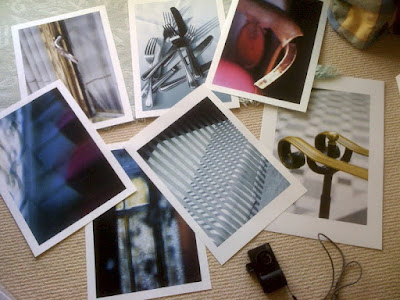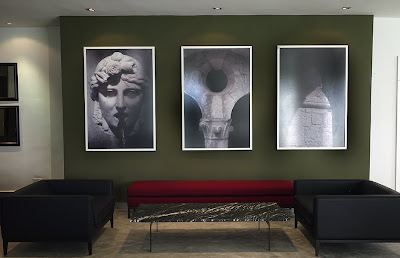.jpg)
I have been lazy. I have not printed a decent image for over 18 months, yes, that's one and a half years (!) Don't get me wrong, I have taken lots of photographs in that period, but I admit, I have not properly printed a proof or exhibition print till today. What a revival feeling it brought!
3 years ago, I purchased a used Epson R1800 photo printer from Michael Freeman, and boy it was a brilliant machine, capable of printing 13" x 19" prints with archival colour inks. It sits sadly on one side of my study, untouched for that long, whilst I happily churned away with mediocre stuff on my HP all-in-one desktop printer, that's even got wireless connectivity.
This afternoon, for fear of clogged print heads damaging the Epson, I took myself to task of resurrecting 'the machine' and ran a sample A4 word document through it. It sort of made all the correct noises, beeping and clicking like a bleeding R2D2, and finally the paper was spewed out at the front...nothing...just very feint lines of blue, red and black spots..arrgh! Nevertheless, I persevered and ran two, no three cleaning cycles on it, before it produced a perfect test print. That took over 30 minutes.
I still have 3 boxes of A3 matt-heavyweight paper stacked under my desk, so I decided to make proof prints of some of my photographs from my current 'on-going' (yea, for 4 years) project titled LUMINA ( watch out for it, its a stunner, he says).

Well., the boy's pleased. I'm a happy bunny and all that.
Colours were slightly off, needs tweaking, but who cares, for now. I remembered Ralph Gibson saying in a workshop with him in 2002 that he often makes rough prints of his works and sticks them on his wall, and everyday, he would stare at them, until he gets bored, trying to understand each image, as he makes some more. Perhaps I'll make a point of doing just that. Images that dwell in hard drives and memory cards are next to useless. You make them and forget about them. I have tons of these, and only revert to good memory to pick them out, despite a fairly efficient filing system I have developed.
The other thing to note is this.
Camera manufacturers are constantly shoving up our noses with higher megapixel counts, 5 million, 7 million, 10 million, 13 million, 21 million, 24 million,..and, like suckers, we consumers only know one thing, the bigger, higher, more..the better and we are slurping these machines up like there's no tomorrow. Yes, big is good, for commercial photographers who print posters.
When was the last time you made a large print?
I mean, large, not 5" x 7" or 8" x 10". No, not A4 or A3 even. Earlier this year, I selected 4 of my black and white architectural studies taken in a French monastery last year to be enlarged to about 1 m x 1.5 m, something like 3 feet x 5 feet to grace a showroom wall in KL. The resolution was stunning at that size and the original files came from a 5-million pixel camera. At first, I had reservations about going that large but after some initial patch testing, I thought it would hold up, and it certainly did. I hope the ID guy was pleased.

A good 8 - 10 MP DSLR would be sufficient to produce a typical magazine spread ie. A3 size, and depending on the quality of lens resolution you have, you can go larger. I did say DSLR, and not compact digitals of equivalent MP count. These are just not in the same league due to technical constraints of sensors but I won't go into all that.
So, my take is this. If all you are ever going to do are 5"x 7"s and the occasional A4 or A3 prints, you could save a packet by looking out for older DSLRs, from 2 or 3 years ago, around 6 - 8 MPs, and smile!

7 comments:
Thanks for sharing.
I am finding myself getting quite interested in seeing people's workflow recently. And coincidentally was reading how someone organizes his negatives and printing (Here: http://kenshukan.net/john/archives/category/photography/)
p/s - I recognize those forks and spoons!
Hi Jayna,
Thanks for your visit. Yes, those were the forks and knives from the weekend, I like them so much. Its sort of works in my series.
I had a look at the valerian article, his method of storage is certainly better than mine, when i was doing darkroom stuff, much more organised. I still have 4 thick A4 binders of negatives rotting away somewhere...
I am awaiting the arrival of a book I had been searching for, called 'Contact:Theory' which was recommended reading. It just shows contact sheets from famous photographers, explaining how they got their wellknown shots. Basically, showing the thought process before and after their best shots. I found it on amazon used last week.
those pictures of yours is very nice.
creative.
Couldn't agree more with you :) Working in a "camera" company I know that the Marketing team have always been pressured by the "market" & industry by having more MP on the new cameras. Apart from the need to constantly upgrade your HDD, transferring the images from the removable media is such a hassle at times ;)
Good pics anyway...
WONG.
Steven, Great posting full of new information and idea. I am just at the Primary level into photography and these knowledge would be of great help to me, especially so in my golden age.
It is posting like this that made the differences to amateur like me.
Thanks and do have a nice day.
Hi Rizal,
Thanks you for your visit and comment. Yasmin Ahmad said there are no creative people, just good observers.
Learn to observe the space and objects around you and you will see a lot more!
Hi Wong (DeZemBer)
Which camera company are you working in? Care to share their marketing strategy, it would make interesting reading.
Dear Pak Idrus,
You are already a great observer of the world around you, in writing and now in photos!
Wow, great article, I really appreciate your thought process and having it explained properly, thank you! I really like this post.
Post a Comment